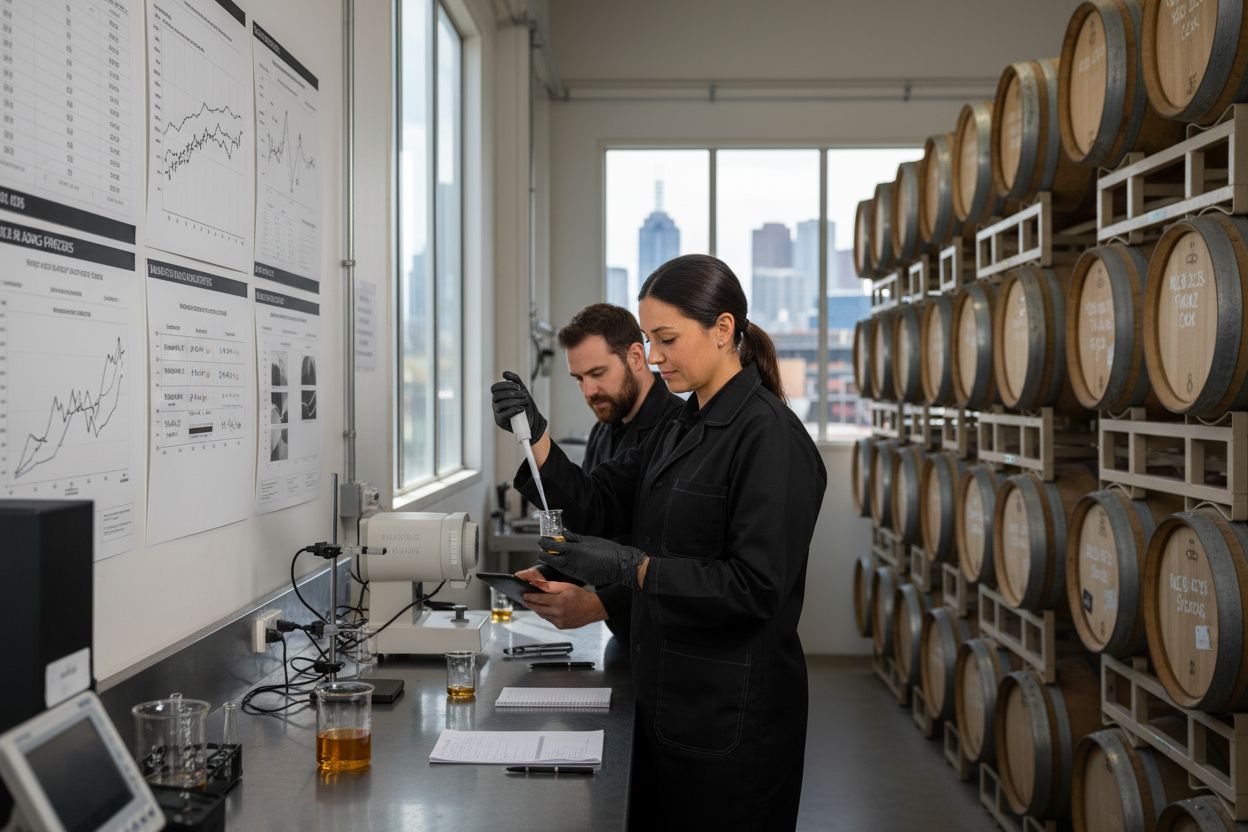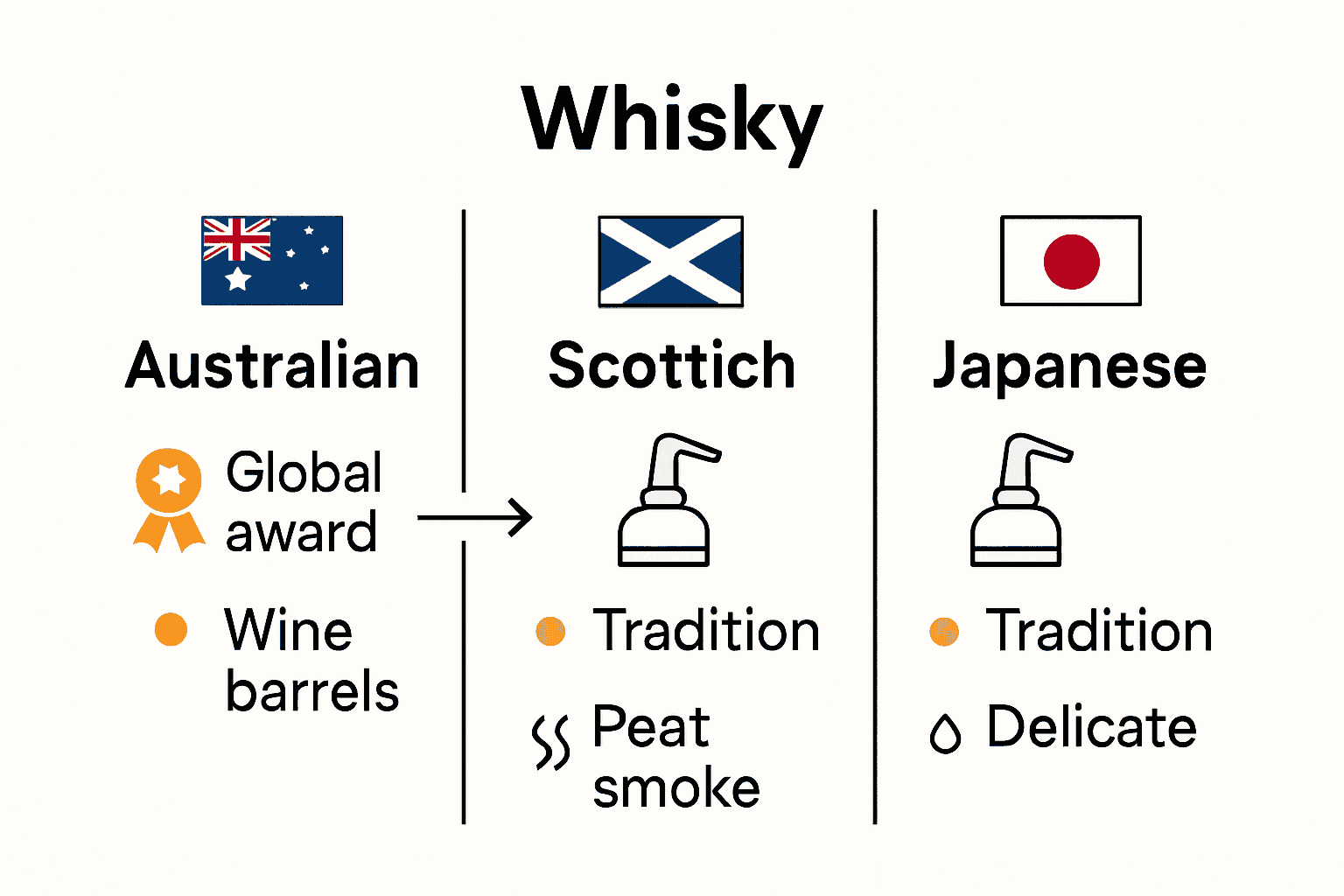Australia’s whisky scene has stunned the world, with over 100 international awards earned by local distilleries in 2025 alone. Whisky lovers and collectors are discovering that what started with one small Tasmanian distillery nearly two centuries ago now rivals the oldest traditions in Scotland and Japan. Today’s Australian whisky offers creative flavors, a bold approach to production, and a fresh narrative that’s challenging everything we thought we knew about this iconic spirit.
Key Takeaways
| Point | Details |
|---|---|
| Australian Whisky’s Evolution | The industry began in 1822, evolving through distinct phases, with a modern renaissance starting in the 1990s, driven by craft distillers. |
| Unique Production Techniques | Australian distilleries utilize innovative methods like wine cask aging and high-altitude distillation, differentiating their products globally. |
| International Recognition | Australian whisky has gained acclaim, highlighted by Sullivans Cove’s 2014 win of the world’s best single malt, marking a shift in global perceptions. |
| Environmental Challenges and Opportunities | The industry faces sustainability challenges but also benefits from unique climatic conditions that enhance flavor profiles. |
Table of Contents
- Defining Australian Whisky And Its Origins
- Unique Production Methods And Climate Impact
- Key Distilleries Shaping The Market
- Global Recognition And Awards Driving Growth
- Comparisons With Scottish And Japanese Whisky
- Challenges, Risks, And Market Opportunities
Defining Australian Whisky And Its Origins
Australian whisky represents a remarkable journey of innovation and passion, tracing its roots back to the early colonial period. Whisky distilling in Australia began officially in 1822, when the first legal distillery opened near Hobart, Tasmania. According to historical records, the industry has experienced three distinct transformative phases: colonial malt production (1863–1929), blended whisky era (1930–1980), and the contemporary boutique whisky renaissance starting around 1992.
The modern reinvention of Australian whisky emerged in the early 1990s, driven by passionate craft distillers who saw immense potential in local whisky production. Small Concern Distillery pioneered this new wave, producing the first modern-era Australian whisky around 1991. Quickly following this breakthrough, influential distilleries like Lark Distillery launched in 1992, sparking what would become a significant craft distilling movement.
Key milestones in Australian whisky’s evolution include the establishment of groundbreaking distilleries:
- Lark Distillery (1992)
- Limeburners (2004)
- Overeem (2007)
- Nant (2008)
- Starward (2009)
These craft producers transformed Australia’s whisky landscape, moving beyond traditional production methods and creating unique expressions that capture the country’s distinctive terroir and innovative spirit. Their commitment to quality and experimentation has positioned Australian whisky as a respected global competitor, attracting international recognition and challenging traditional whisky-producing nations.
Unique Production Methods And Climate Impact
Australian whisky distinguishes itself through extraordinary production techniques that leverage the continent’s diverse and dramatic climate. Unlike traditional whisky-producing regions, Australian distilleries harness unique geographical conditions to create exceptional spirits. According to Master of Malt, distilleries across different regions exploit distinct climatic advantages that dramatically influence whisky character.
Geographical diversity plays a crucial role in Australian whisky production. For instance, high-altitude distilleries like Wild River in Queensland benefit from superior temperature control, while inland New South Wales locations experience extreme temperature variations. These hot summers and cold winters accelerate maturation processes, enabling faster and more intense oak interaction. Sullivan’s Cove in Tasmania offers another remarkable example, with its rare coastal temperate climate allowing for longer, gentler ageing processes that develop nuanced flavour profiles.
Some Australian distilleries have pioneered innovative maturation techniques that set them apart globally. Wine cask maturation has become a signature approach, with distilleries like Starward exclusively using wine casks from the renowned Barossa Valley. This method ingeniously leverages Australia’s vibrant wine industry, imparting unique flavour characteristics that traditional Scottish or Irish whiskies cannot replicate.
Key innovations in Australian whisky production include:
- High-altitude distillation for precise temperature management
- Extreme seasonal temperature variations accelerating maturation
- Exclusive wine cask ageing techniques
- Coastal and inland climate variations influencing flavour development
These distinctive production methods transform Australian whisky from a niche curiosity into a globally recognized premium spirit, showcasing how geographical uniqueness can revolutionize traditional whisky-making practices.

Here’s a comparison of key innovations in Australian whisky production methods:
| Innovation | Description | Notable Distilleries |
|---|---|---|
| High-altitude distillation | Enhanced temperature control for maturation | Wild River |
| Extreme seasonal variation | Accelerated whisky maturation | NSW inland distilleries |
| Wine cask ageing | Exclusive use of wine barrels | Starward |
| Coastal/temperate climate | Gentler, longer ageing processes | Sullivan’s Cove |
Key Distilleries Shaping The Market
The Australian whisky landscape is being dramatically reshaped by innovative and award-winning craft distilleries that are pushing boundaries and challenging global perceptions. At the forefront of this revolution stands Hellyers Road Distillery in Tasmania, which has emerged as a pivotal player in the industry since its founding in 1997. Our guide on Australian whisky types highlights the significant impact of such pioneering producers.
Hellyers Road Distillery has garnered international acclaim, securing multiple prestigious awards at the World Whisky Awards. In 2021 and 2022, they clinched top honours including Best Australian Single Malt and Best 12 Year Old categories, demonstrating the exceptional quality and craftsmanship of Australian whisky. Similarly, Archie Rose Distilling Co. from Sydney has established itself as a powerhouse of innovation, winning multiple accolades such as World’s Best Rye Whisky and several Australia’s Best Single Malt awards.
These distilleries represent more than just spirit producers; they are cultural ambassadors redefining the global whisky narrative. Their approach combines traditional techniques with bold experimentation, creating unique expressions that reflect Australia’s diverse terroir and innovative spirit. Key characteristics that set these distilleries apart include:
- Commitment to local ingredients
- Innovative maturation techniques
- Willingness to experiment with unconventional cask selections
- Strong focus on small-batch, quality-driven production
By consistently pushing boundaries and winning international recognition, these distilleries are not just producing whisky—they’re crafting a new global reputation for Australian spirits, transforming the country from an emerging whisky region to a respected international producer.
Global Recognition And Awards Driving Growth
The global whisky landscape has been dramatically transformed by international awards that have thrust Australian whisky into the spotlight. A pivotal moment came in 2014 when Sullivans Cove achieved an unprecedented milestone by winning the world’s best single malt—becoming the first non-Scottish or Japanese distillery to receive such a prestigious global accolade. Our comprehensive whisky guide explores how such recognition can reshape an entire industry.
According to recent industry reports, Australian whisky has continued its remarkable ascent. At the 2025 World Whiskies Awards, the nation’s distilleries secured an impressive collection of over 100 awards across 30 different producers. Tasmanian distilleries like Hellyers Road, Sullivans Cove, and Callington Mill led the charge, while Whipper Snapper from Western Australia claimed multiple national categories. The awards included 30 Gold medals, signaling a significant leap in global perception and quality.
Key international achievements that have driven Australian whisky’s growth include:
- First non-traditional whisky region to win world’s best single malt (2014)
- World’s best single cask malt awards in 2018 and 2019
- Archie Rose winning world’s best rye whisky in 2020
- Over 100 international awards in 2025, showcasing consistent quality
These accolades represent more than just trophies—they demonstrate Australia’s emerging status as a serious, innovative whisky-producing nation.
By challenging traditional whisky-making paradigms and delivering exceptional quality, Australian distilleries are rewriting the global spirits narrative and attracting international collectors, enthusiasts, and investors.
Comparisons With Scottish And Japanese Whisky
Australian whisky has emerged as a formidable contender in the global spirits arena, challenging the long-established traditions of Scottish and Japanese whisky production. A watershed moment came in 2014 when Sullivans Cove won the world’s best single malt—the first time a whisky outside Scotland or Japan had claimed this prestigious title. Learn more about whisky styles reveals the nuanced distinctions between these remarkable whisky-producing cultures.
Unlike the rigid traditional approaches of Scottish and Japanese distilleries, Australian whisky makers have demonstrated remarkable flexibility and innovation. According to industry sources, Australian distillers have expanded beyond traditional single malt categories, boldly producing diverse styles including bourbon-style, rye, and experimental blended whiskies. This approach allows them to create unique expressions that cater to varied consumer preferences and price points, with many exceptional bottles available under AUD 100.
Key differences between Australian and traditional whisky approaches include:
- More experimental mashbill compositions
- Willingness to break traditional production rules
- Leveraging unique local terroir and climate conditions
- Broader range of cask and maturation techniques
- More accessible pricing strategies
While Scottish whisky remains rooted in centuries-old traditions and Japanese whisky emphasizes precision and minimalism, Australian whisky represents a new frontier of creativity. By combining technical excellence with innovative spirit, Australian distilleries are not just imitating established traditions but creating an entirely new whisky narrative that challenges global expectations.

Challenges, Risks, And Market Opportunities
The Australian whisky industry stands at a critical juncture, balancing remarkable potential with significant environmental and production challenges. As of 2020, the industry remains relatively small, with approximately 50 distilleries producing whisky nationwide. Our guide to whisky styles explores the nuanced landscape of these emerging producers.
Environmental sustainability has emerged as a crucial consideration for Australian whisky producers. According to industry research, distilleries are confronting significant challenges including high water usage, energy-intensive distillation processes, and complex waste management. Innovative distilleries are responding by implementing water conservation techniques, adopting energy-efficient technologies, and developing sophisticated waste management strategies to mitigate their environmental footprint.
Key challenges and opportunities in the Australian whisky market include:
- Limited local production capacity (50 distilleries as of 2020)
- High ‘angel’s share’ evaporation rates due to extreme climate conditions
- Rising global recognition creating market expansion potential
- Need for sustainable production practices
- Increasing international market interest
The industry’s unique climate presents both risks and opportunities. Australia’s extreme temperatures accelerate whisky maturation but also increase evaporation rates, potentially constraining long-term supply. However, these same challenging conditions create distinctive flavor profiles that set Australian whisky apart in the global marketplace, transforming potential limitations into competitive advantages for innovative producers.
Discover and Experience the Bold Rise of Australian Whisky
Have you been inspired by the innovation, climate-driven character, and global recognition outlined in our deep dive on Australian whisky? If you are keen to experience the unique expressions and taste the award-winning spirits that are reshaping whisky culture, this is your perfect entry point. Whether you are searching for boutique distilleries, exclusive wine cask expressions, or simply want to support sustainable and boundary-pushing producers, you will find the region’s most exciting bottles here. We help you overcome the classic challenge: finding authentic, truly local Australian whiskies without the overwhelm or risk of missing limited releases. Check our educational whisky articles for more insight, and let your collection reflect the spirit of a rising whisky nation.

Start exploring the next chapter in whisky evolution by browsing our expertly curated Australian whisky range at Uisuki.com.au. Discover new arrivals, acclaimed favourites, and rare collector’s pieces before they are gone. For tailored recommendations or sourcing specific bottles, reach out directly through our site and unlock a world of whisky waiting for you. There has never been a better time to celebrate Australia’s golden age of whisky.
Frequently Asked Questions
What defines Australian whisky compared to other types?
Australian whisky is characterized by its diverse production methods, unique geographical influences, and innovative approaches. Unlike traditional whisky, Australian distillers often utilize local ingredients and experiment with wine cask aging, resulting in distinct flavor profiles.
How have production methods influenced the flavor of Australian whisky?
Australian distilleries leverage high-altitude climates, extreme seasonal variations, and unique maturation techniques, such as wine cask aging. These innovations enhance the whisky’s character, often resulting in richer, more complex flavors than those found in traditional whiskies.
What key distilleries are contributing to the rise of Australian whisky?
Pivotal distilleries shaping the Australian whisky landscape include Hellyers Road Distillery, Lark Distillery, and Archie Rose Distilling Co. These producers are known for their commitment to quality, innovative practices, and numerous international awards.
What significant accolades have Australian whiskies received in recent years?
Australian whiskies have garnered international recognition, including winning the title of the world’s best single malt in 2014 and achieving over 100 awards at the 2025 World Whiskies Awards. These achievements demonstrate the industry’s rising quality and global standing.

